Human Resource Management: Reward Systems in Singapore and Hanoi
VerifiedAdded on 2022/09/07
|11
|3824
|19
Report
AI Summary
This report provides a comprehensive analysis of reward systems within the context of Human Resource Management (HRM). It begins by defining the objectives of reward systems, emphasizing their role in aligning organizational and personnel goals, attracting and retaining skilled employees, empowering staff, aligning risk preferences, and ensuring legal compliance. The report then delves into the specific application of reward systems in Singapore, highlighting the importance of understanding the distinction between rewards and recognition, clarifying performance goals, and utilizing key performance indicators. Furthermore, the report explores the design of reward systems in Singapore, advocating for career advancement, employee engagement, and real-time analytics. The study extends its scope to Hanoi, Vietnam, where it examines the purposes of reward systems, including attracting, motivating, and retaining employees. The report underscores the impact of reward systems on employee attitudes and behaviors, and the crucial role they play in organizational performance. The report also references the case of Cheesy Pizza company in Singapore and Vietnam to illustrate practical applications of reward systems. Finally, the report explores the design of reward systems in Hanoi, focusing on its impact on organizational performance.
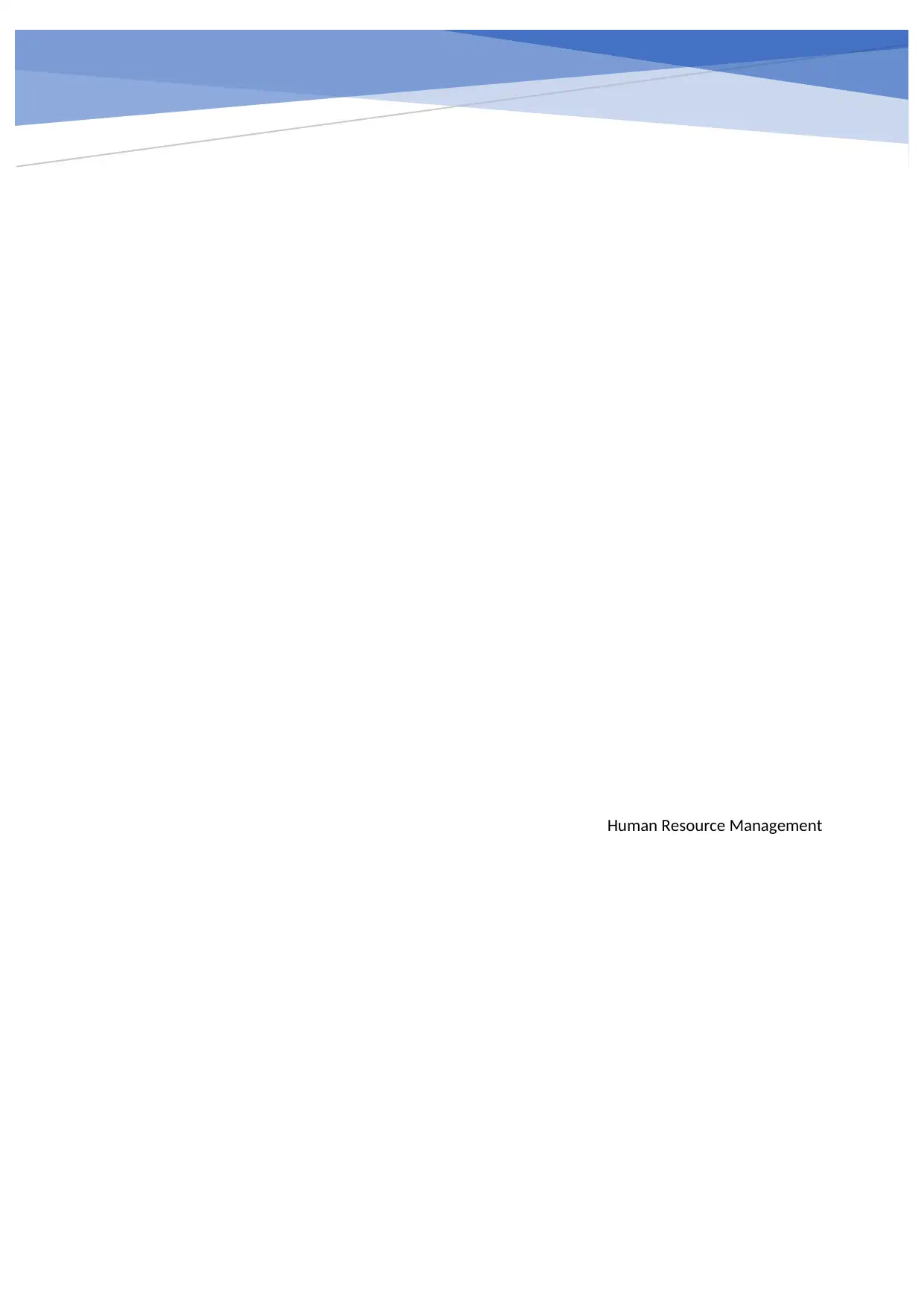
Human Resource Management
Paraphrase This Document
Need a fresh take? Get an instant paraphrase of this document with our AI Paraphraser
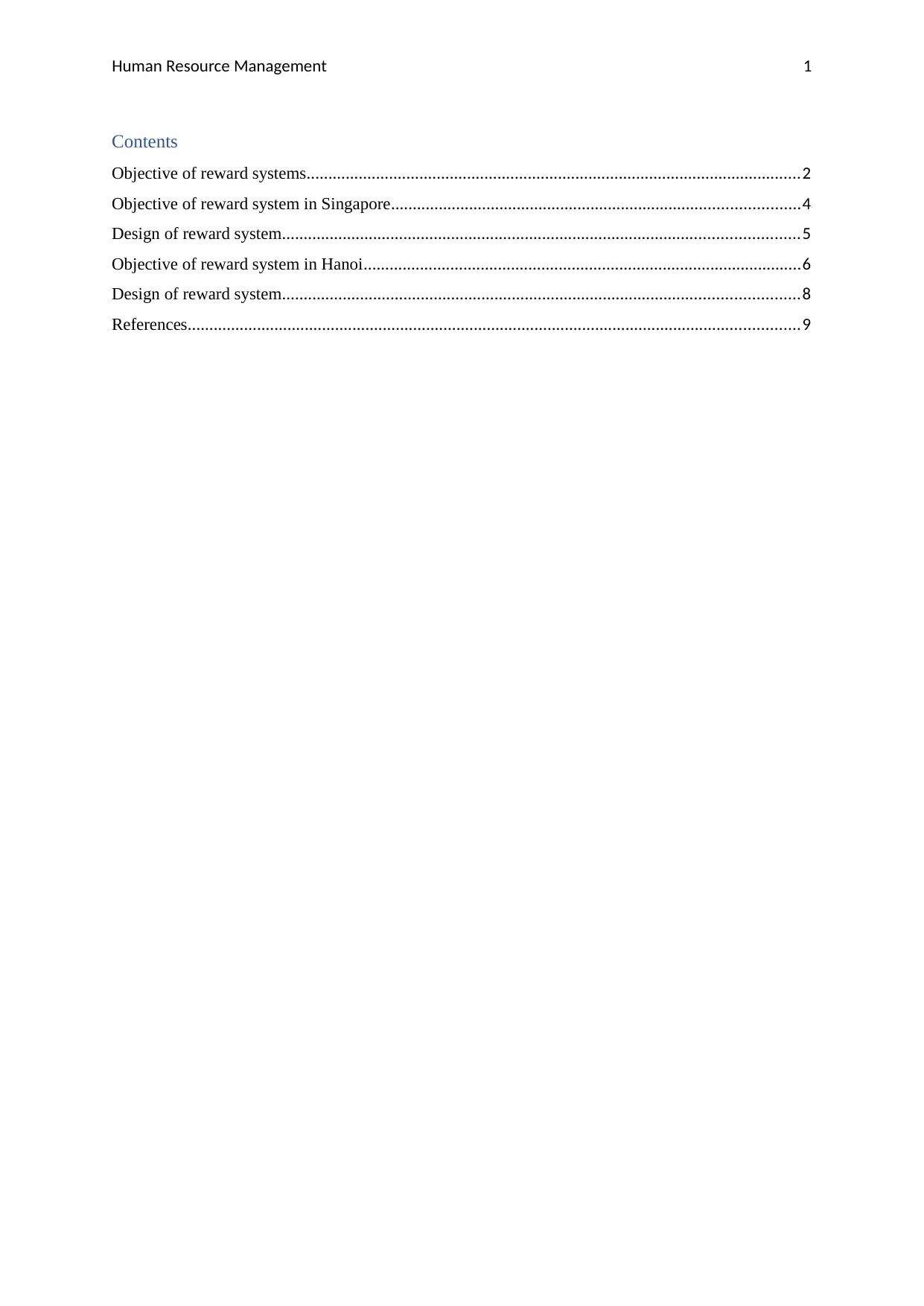
Human Resource Management 1
Contents
Objective of reward systems..................................................................................................................2
Objective of reward system in Singapore..............................................................................................4
Design of reward system.......................................................................................................................5
Objective of reward system in Hanoi.....................................................................................................6
Design of reward system.......................................................................................................................8
References.............................................................................................................................................9
Contents
Objective of reward systems..................................................................................................................2
Objective of reward system in Singapore..............................................................................................4
Design of reward system.......................................................................................................................5
Objective of reward system in Hanoi.....................................................................................................6
Design of reward system.......................................................................................................................8
References.............................................................................................................................................9
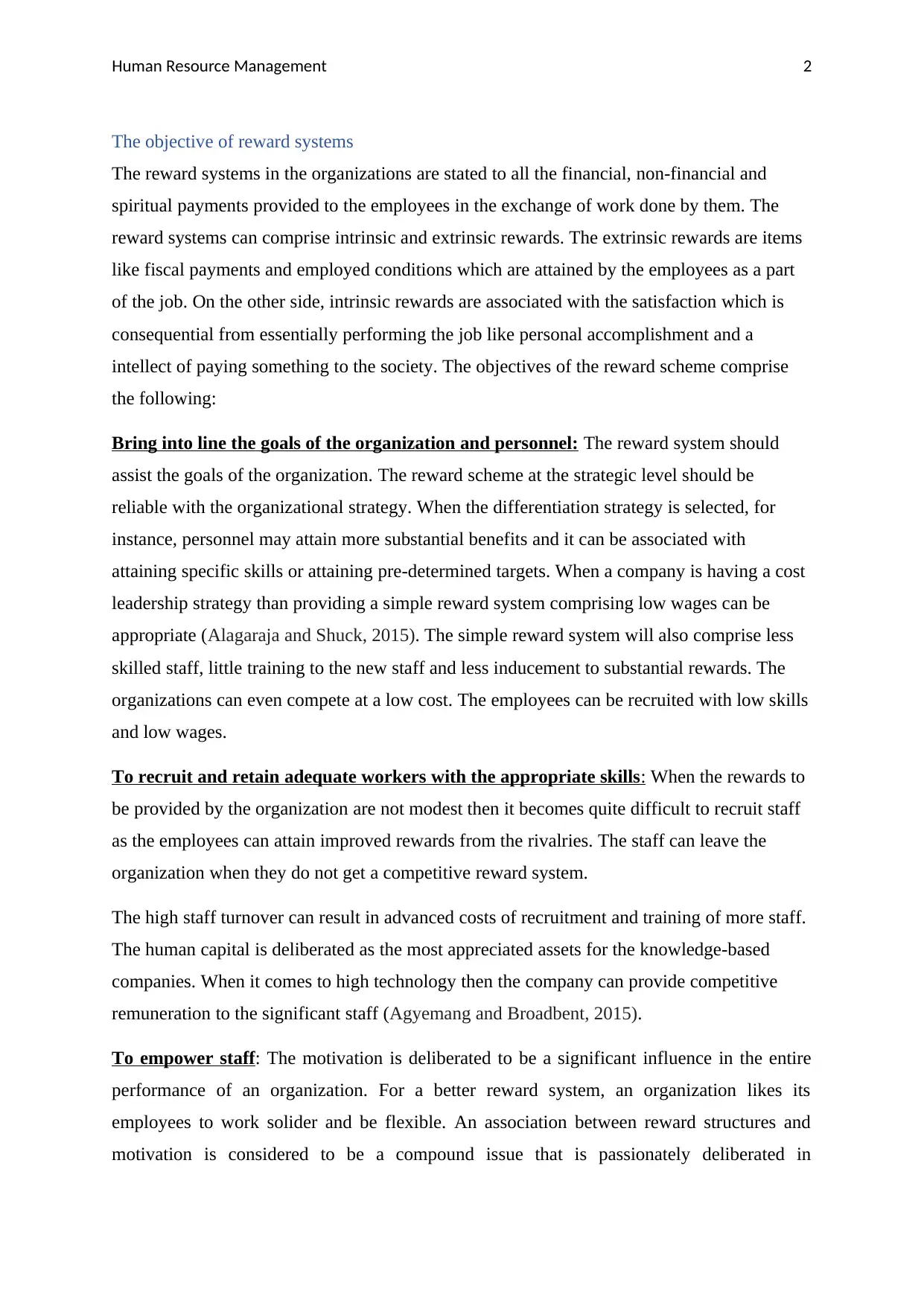
Human Resource Management 2
The objective of reward systems
The reward systems in the organizations are stated to all the financial, non-financial and
spiritual payments provided to the employees in the exchange of work done by them. The
reward systems can comprise intrinsic and extrinsic rewards. The extrinsic rewards are items
like fiscal payments and employed conditions which are attained by the employees as a part
of the job. On the other side, intrinsic rewards are associated with the satisfaction which is
consequential from essentially performing the job like personal accomplishment and a
intellect of paying something to the society. The objectives of the reward scheme comprise
the following:
Bring into line the goals of the organization and personnel: The reward system should
assist the goals of the organization. The reward scheme at the strategic level should be
reliable with the organizational strategy. When the differentiation strategy is selected, for
instance, personnel may attain more substantial benefits and it can be associated with
attaining specific skills or attaining pre-determined targets. When a company is having a cost
leadership strategy than providing a simple reward system comprising low wages can be
appropriate (Alagaraja and Shuck, 2015). The simple reward system will also comprise less
skilled staff, little training to the new staff and less inducement to substantial rewards. The
organizations can even compete at a low cost. The employees can be recruited with low skills
and low wages.
To recruit and retain adequate workers with the appropriate skills: When the rewards to
be provided by the organization are not modest then it becomes quite difficult to recruit staff
as the employees can attain improved rewards from the rivalries. The staff can leave the
organization when they do not get a competitive reward system.
The high staff turnover can result in advanced costs of recruitment and training of more staff.
The human capital is deliberated as the most appreciated assets for the knowledge-based
companies. When it comes to high technology then the company can provide competitive
remuneration to the significant staff (Agyemang and Broadbent, 2015).
To empower staff: The motivation is deliberated to be a significant influence in the entire
performance of an organization. For a better reward system, an organization likes its
employees to work solider and be flexible. An association between reward structures and
motivation is considered to be a compound issue that is passionately deliberated in
The objective of reward systems
The reward systems in the organizations are stated to all the financial, non-financial and
spiritual payments provided to the employees in the exchange of work done by them. The
reward systems can comprise intrinsic and extrinsic rewards. The extrinsic rewards are items
like fiscal payments and employed conditions which are attained by the employees as a part
of the job. On the other side, intrinsic rewards are associated with the satisfaction which is
consequential from essentially performing the job like personal accomplishment and a
intellect of paying something to the society. The objectives of the reward scheme comprise
the following:
Bring into line the goals of the organization and personnel: The reward system should
assist the goals of the organization. The reward scheme at the strategic level should be
reliable with the organizational strategy. When the differentiation strategy is selected, for
instance, personnel may attain more substantial benefits and it can be associated with
attaining specific skills or attaining pre-determined targets. When a company is having a cost
leadership strategy than providing a simple reward system comprising low wages can be
appropriate (Alagaraja and Shuck, 2015). The simple reward system will also comprise less
skilled staff, little training to the new staff and less inducement to substantial rewards. The
organizations can even compete at a low cost. The employees can be recruited with low skills
and low wages.
To recruit and retain adequate workers with the appropriate skills: When the rewards to
be provided by the organization are not modest then it becomes quite difficult to recruit staff
as the employees can attain improved rewards from the rivalries. The staff can leave the
organization when they do not get a competitive reward system.
The high staff turnover can result in advanced costs of recruitment and training of more staff.
The human capital is deliberated as the most appreciated assets for the knowledge-based
companies. When it comes to high technology then the company can provide competitive
remuneration to the significant staff (Agyemang and Broadbent, 2015).
To empower staff: The motivation is deliberated to be a significant influence in the entire
performance of an organization. For a better reward system, an organization likes its
employees to work solider and be flexible. An association between reward structures and
motivation is considered to be a compound issue that is passionately deliberated in
⊘ This is a preview!⊘
Do you want full access?
Subscribe today to unlock all pages.

Trusted by 1+ million students worldwide
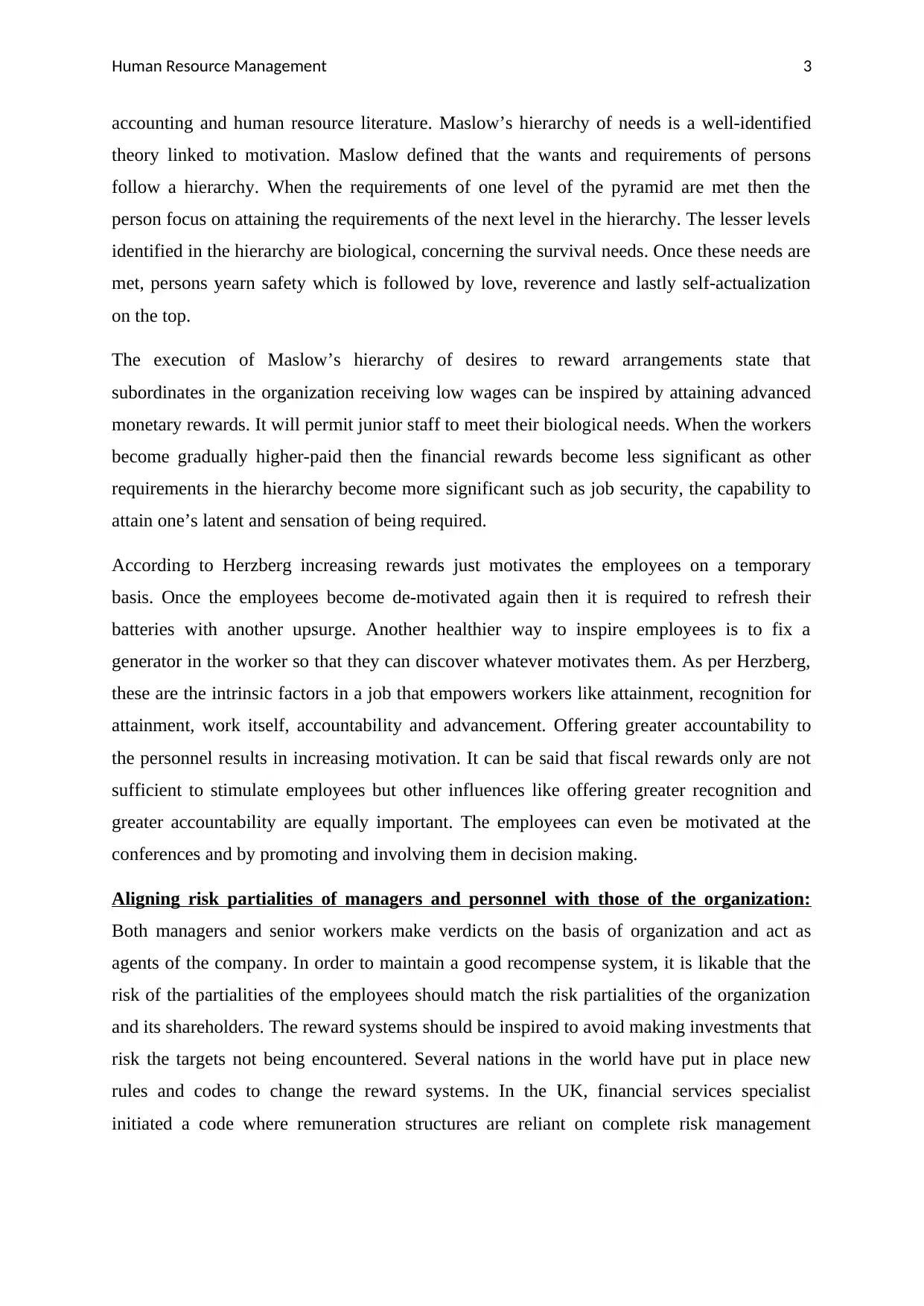
Human Resource Management 3
accounting and human resource literature. Maslow’s hierarchy of needs is a well-identified
theory linked to motivation. Maslow defined that the wants and requirements of persons
follow a hierarchy. When the requirements of one level of the pyramid are met then the
person focus on attaining the requirements of the next level in the hierarchy. The lesser levels
identified in the hierarchy are biological, concerning the survival needs. Once these needs are
met, persons yearn safety which is followed by love, reverence and lastly self-actualization
on the top.
The execution of Maslow’s hierarchy of desires to reward arrangements state that
subordinates in the organization receiving low wages can be inspired by attaining advanced
monetary rewards. It will permit junior staff to meet their biological needs. When the workers
become gradually higher-paid then the financial rewards become less significant as other
requirements in the hierarchy become more significant such as job security, the capability to
attain one’s latent and sensation of being required.
According to Herzberg increasing rewards just motivates the employees on a temporary
basis. Once the employees become de-motivated again then it is required to refresh their
batteries with another upsurge. Another healthier way to inspire employees is to fix a
generator in the worker so that they can discover whatever motivates them. As per Herzberg,
these are the intrinsic factors in a job that empowers workers like attainment, recognition for
attainment, work itself, accountability and advancement. Offering greater accountability to
the personnel results in increasing motivation. It can be said that fiscal rewards only are not
sufficient to stimulate employees but other influences like offering greater recognition and
greater accountability are equally important. The employees can even be motivated at the
conferences and by promoting and involving them in decision making.
Aligning risk partialities of managers and personnel with those of the organization:
Both managers and senior workers make verdicts on the basis of organization and act as
agents of the company. In order to maintain a good recompense system, it is likable that the
risk of the partialities of the employees should match the risk partialities of the organization
and its shareholders. The reward systems should be inspired to avoid making investments that
risk the targets not being encountered. Several nations in the world have put in place new
rules and codes to change the reward systems. In the UK, financial services specialist
initiated a code where remuneration structures are reliant on complete risk management
accounting and human resource literature. Maslow’s hierarchy of needs is a well-identified
theory linked to motivation. Maslow defined that the wants and requirements of persons
follow a hierarchy. When the requirements of one level of the pyramid are met then the
person focus on attaining the requirements of the next level in the hierarchy. The lesser levels
identified in the hierarchy are biological, concerning the survival needs. Once these needs are
met, persons yearn safety which is followed by love, reverence and lastly self-actualization
on the top.
The execution of Maslow’s hierarchy of desires to reward arrangements state that
subordinates in the organization receiving low wages can be inspired by attaining advanced
monetary rewards. It will permit junior staff to meet their biological needs. When the workers
become gradually higher-paid then the financial rewards become less significant as other
requirements in the hierarchy become more significant such as job security, the capability to
attain one’s latent and sensation of being required.
According to Herzberg increasing rewards just motivates the employees on a temporary
basis. Once the employees become de-motivated again then it is required to refresh their
batteries with another upsurge. Another healthier way to inspire employees is to fix a
generator in the worker so that they can discover whatever motivates them. As per Herzberg,
these are the intrinsic factors in a job that empowers workers like attainment, recognition for
attainment, work itself, accountability and advancement. Offering greater accountability to
the personnel results in increasing motivation. It can be said that fiscal rewards only are not
sufficient to stimulate employees but other influences like offering greater recognition and
greater accountability are equally important. The employees can even be motivated at the
conferences and by promoting and involving them in decision making.
Aligning risk partialities of managers and personnel with those of the organization:
Both managers and senior workers make verdicts on the basis of organization and act as
agents of the company. In order to maintain a good recompense system, it is likable that the
risk of the partialities of the employees should match the risk partialities of the organization
and its shareholders. The reward systems should be inspired to avoid making investments that
risk the targets not being encountered. Several nations in the world have put in place new
rules and codes to change the reward systems. In the UK, financial services specialist
initiated a code where remuneration structures are reliant on complete risk management
Paraphrase This Document
Need a fresh take? Get an instant paraphrase of this document with our AI Paraphraser
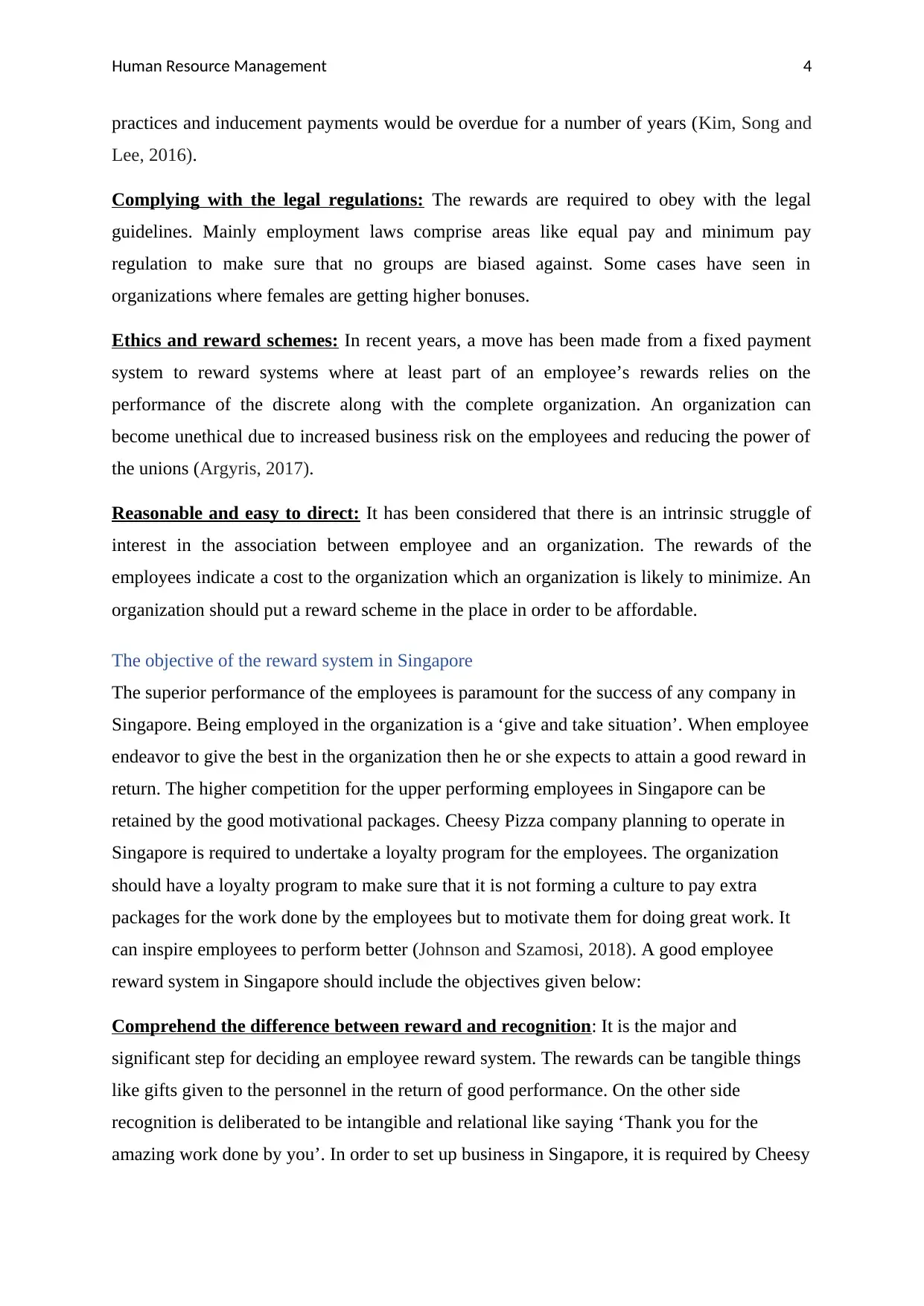
Human Resource Management 4
practices and inducement payments would be overdue for a number of years (Kim, Song and
Lee, 2016).
Complying with the legal regulations: The rewards are required to obey with the legal
guidelines. Mainly employment laws comprise areas like equal pay and minimum pay
regulation to make sure that no groups are biased against. Some cases have seen in
organizations where females are getting higher bonuses.
Ethics and reward schemes: In recent years, a move has been made from a fixed payment
system to reward systems where at least part of an employee’s rewards relies on the
performance of the discrete along with the complete organization. An organization can
become unethical due to increased business risk on the employees and reducing the power of
the unions (Argyris, 2017).
Reasonable and easy to direct: It has been considered that there is an intrinsic struggle of
interest in the association between employee and an organization. The rewards of the
employees indicate a cost to the organization which an organization is likely to minimize. An
organization should put a reward scheme in the place in order to be affordable.
The objective of the reward system in Singapore
The superior performance of the employees is paramount for the success of any company in
Singapore. Being employed in the organization is a ‘give and take situation’. When employee
endeavor to give the best in the organization then he or she expects to attain a good reward in
return. The higher competition for the upper performing employees in Singapore can be
retained by the good motivational packages. Cheesy Pizza company planning to operate in
Singapore is required to undertake a loyalty program for the employees. The organization
should have a loyalty program to make sure that it is not forming a culture to pay extra
packages for the work done by the employees but to motivate them for doing great work. It
can inspire employees to perform better (Johnson and Szamosi, 2018). A good employee
reward system in Singapore should include the objectives given below:
Comprehend the difference between reward and recognition: It is the major and
significant step for deciding an employee reward system. The rewards can be tangible things
like gifts given to the personnel in the return of good performance. On the other side
recognition is deliberated to be intangible and relational like saying ‘Thank you for the
amazing work done by you’. In order to set up business in Singapore, it is required by Cheesy
practices and inducement payments would be overdue for a number of years (Kim, Song and
Lee, 2016).
Complying with the legal regulations: The rewards are required to obey with the legal
guidelines. Mainly employment laws comprise areas like equal pay and minimum pay
regulation to make sure that no groups are biased against. Some cases have seen in
organizations where females are getting higher bonuses.
Ethics and reward schemes: In recent years, a move has been made from a fixed payment
system to reward systems where at least part of an employee’s rewards relies on the
performance of the discrete along with the complete organization. An organization can
become unethical due to increased business risk on the employees and reducing the power of
the unions (Argyris, 2017).
Reasonable and easy to direct: It has been considered that there is an intrinsic struggle of
interest in the association between employee and an organization. The rewards of the
employees indicate a cost to the organization which an organization is likely to minimize. An
organization should put a reward scheme in the place in order to be affordable.
The objective of the reward system in Singapore
The superior performance of the employees is paramount for the success of any company in
Singapore. Being employed in the organization is a ‘give and take situation’. When employee
endeavor to give the best in the organization then he or she expects to attain a good reward in
return. The higher competition for the upper performing employees in Singapore can be
retained by the good motivational packages. Cheesy Pizza company planning to operate in
Singapore is required to undertake a loyalty program for the employees. The organization
should have a loyalty program to make sure that it is not forming a culture to pay extra
packages for the work done by the employees but to motivate them for doing great work. It
can inspire employees to perform better (Johnson and Szamosi, 2018). A good employee
reward system in Singapore should include the objectives given below:
Comprehend the difference between reward and recognition: It is the major and
significant step for deciding an employee reward system. The rewards can be tangible things
like gifts given to the personnel in the return of good performance. On the other side
recognition is deliberated to be intangible and relational like saying ‘Thank you for the
amazing work done by you’. In order to set up business in Singapore, it is required by Cheesy
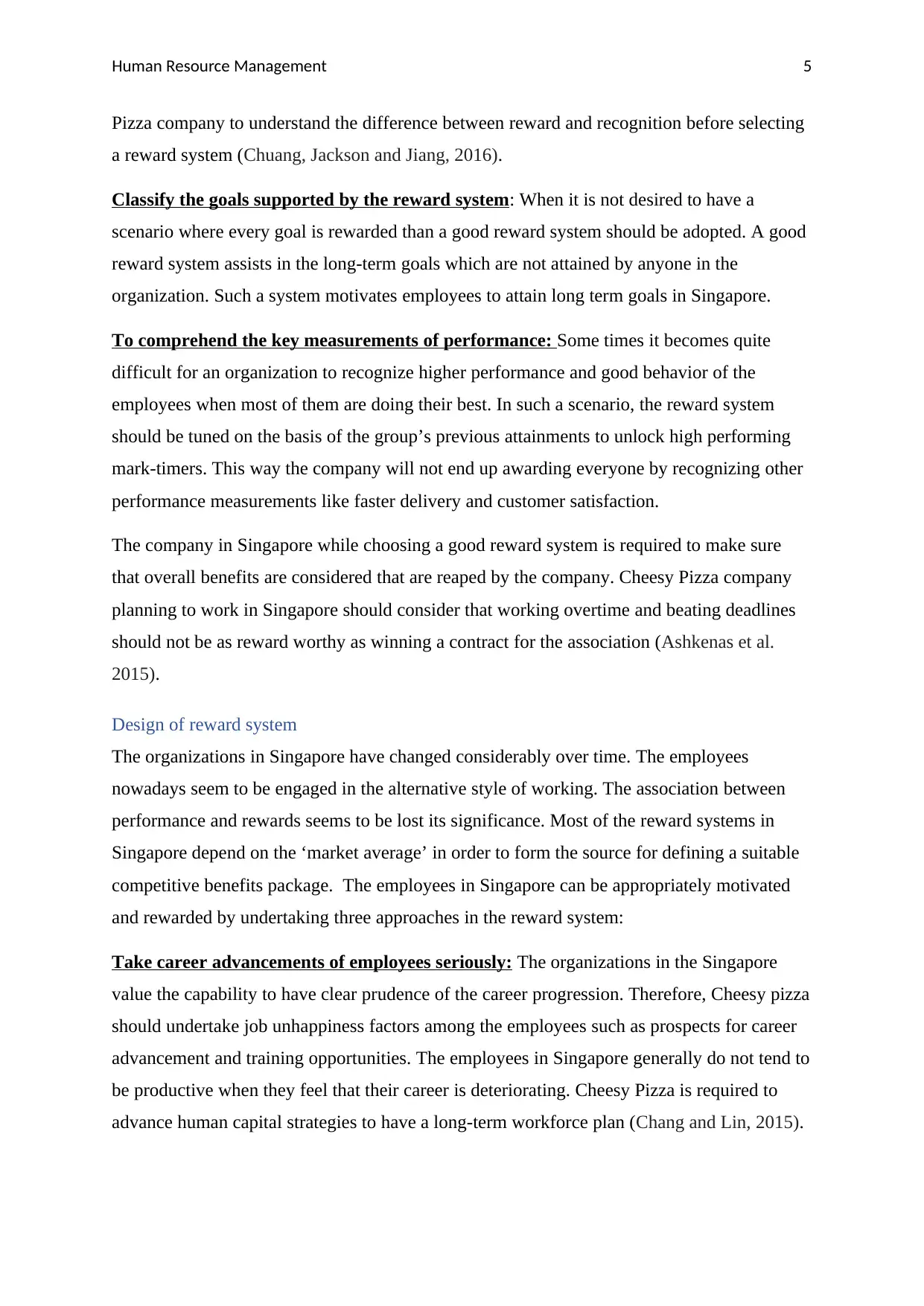
Human Resource Management 5
Pizza company to understand the difference between reward and recognition before selecting
a reward system (Chuang, Jackson and Jiang, 2016).
Classify the goals supported by the reward system: When it is not desired to have a
scenario where every goal is rewarded than a good reward system should be adopted. A good
reward system assists in the long-term goals which are not attained by anyone in the
organization. Such a system motivates employees to attain long term goals in Singapore.
To comprehend the key measurements of performance: Some times it becomes quite
difficult for an organization to recognize higher performance and good behavior of the
employees when most of them are doing their best. In such a scenario, the reward system
should be tuned on the basis of the group’s previous attainments to unlock high performing
mark-timers. This way the company will not end up awarding everyone by recognizing other
performance measurements like faster delivery and customer satisfaction.
The company in Singapore while choosing a good reward system is required to make sure
that overall benefits are considered that are reaped by the company. Cheesy Pizza company
planning to work in Singapore should consider that working overtime and beating deadlines
should not be as reward worthy as winning a contract for the association (Ashkenas et al.
2015).
Design of reward system
The organizations in Singapore have changed considerably over time. The employees
nowadays seem to be engaged in the alternative style of working. The association between
performance and rewards seems to be lost its significance. Most of the reward systems in
Singapore depend on the ‘market average’ in order to form the source for defining a suitable
competitive benefits package. The employees in Singapore can be appropriately motivated
and rewarded by undertaking three approaches in the reward system:
Take career advancements of employees seriously: The organizations in the Singapore
value the capability to have clear prudence of the career progression. Therefore, Cheesy pizza
should undertake job unhappiness factors among the employees such as prospects for career
advancement and training opportunities. The employees in Singapore generally do not tend to
be productive when they feel that their career is deteriorating. Cheesy Pizza is required to
advance human capital strategies to have a long-term workforce plan (Chang and Lin, 2015).
Pizza company to understand the difference between reward and recognition before selecting
a reward system (Chuang, Jackson and Jiang, 2016).
Classify the goals supported by the reward system: When it is not desired to have a
scenario where every goal is rewarded than a good reward system should be adopted. A good
reward system assists in the long-term goals which are not attained by anyone in the
organization. Such a system motivates employees to attain long term goals in Singapore.
To comprehend the key measurements of performance: Some times it becomes quite
difficult for an organization to recognize higher performance and good behavior of the
employees when most of them are doing their best. In such a scenario, the reward system
should be tuned on the basis of the group’s previous attainments to unlock high performing
mark-timers. This way the company will not end up awarding everyone by recognizing other
performance measurements like faster delivery and customer satisfaction.
The company in Singapore while choosing a good reward system is required to make sure
that overall benefits are considered that are reaped by the company. Cheesy Pizza company
planning to work in Singapore should consider that working overtime and beating deadlines
should not be as reward worthy as winning a contract for the association (Ashkenas et al.
2015).
Design of reward system
The organizations in Singapore have changed considerably over time. The employees
nowadays seem to be engaged in the alternative style of working. The association between
performance and rewards seems to be lost its significance. Most of the reward systems in
Singapore depend on the ‘market average’ in order to form the source for defining a suitable
competitive benefits package. The employees in Singapore can be appropriately motivated
and rewarded by undertaking three approaches in the reward system:
Take career advancements of employees seriously: The organizations in the Singapore
value the capability to have clear prudence of the career progression. Therefore, Cheesy pizza
should undertake job unhappiness factors among the employees such as prospects for career
advancement and training opportunities. The employees in Singapore generally do not tend to
be productive when they feel that their career is deteriorating. Cheesy Pizza is required to
advance human capital strategies to have a long-term workforce plan (Chang and Lin, 2015).
⊘ This is a preview!⊘
Do you want full access?
Subscribe today to unlock all pages.

Trusted by 1+ million students worldwide
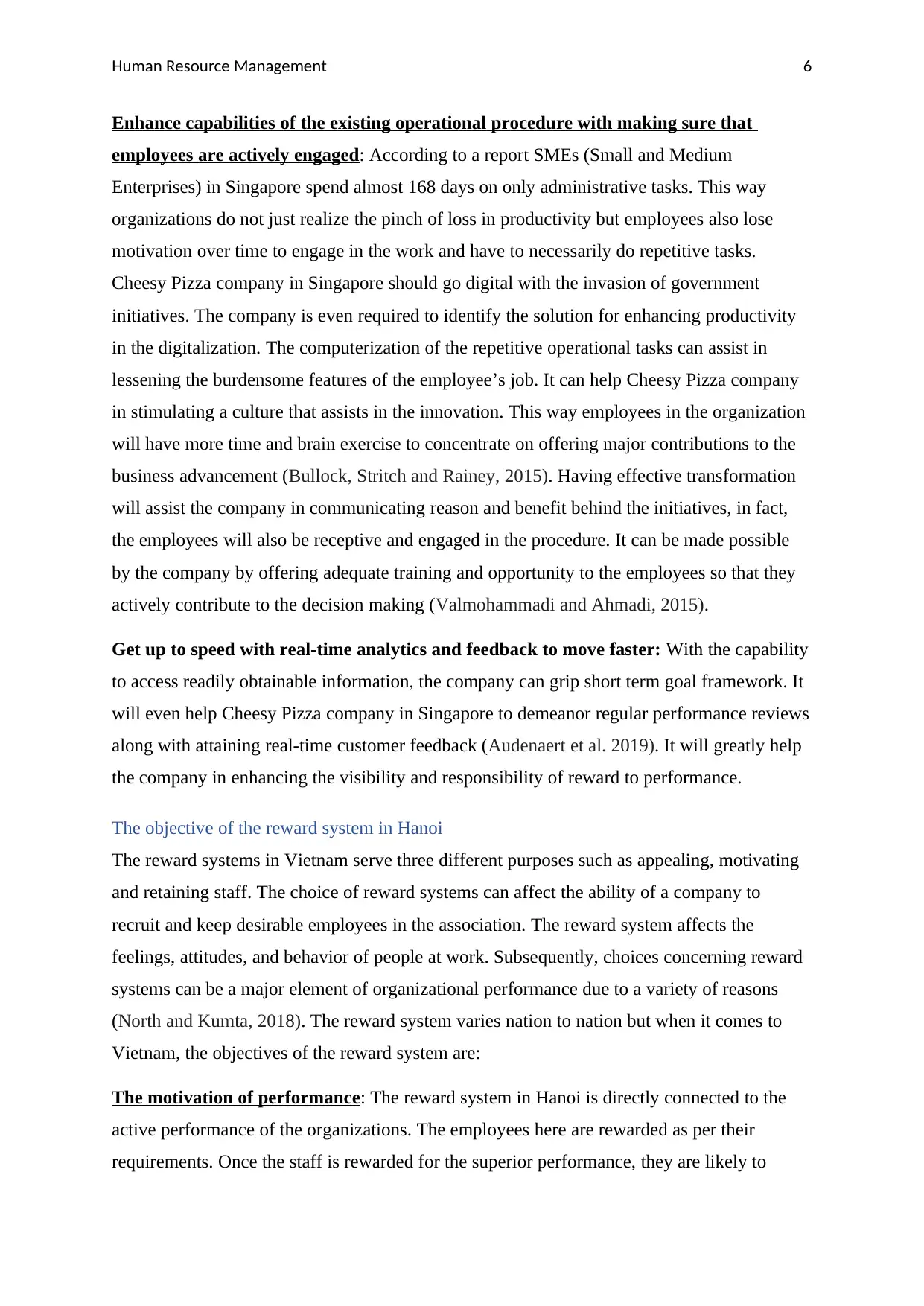
Human Resource Management 6
Enhance capabilities of the existing operational procedure with making sure that
employees are actively engaged: According to a report SMEs (Small and Medium
Enterprises) in Singapore spend almost 168 days on only administrative tasks. This way
organizations do not just realize the pinch of loss in productivity but employees also lose
motivation over time to engage in the work and have to necessarily do repetitive tasks.
Cheesy Pizza company in Singapore should go digital with the invasion of government
initiatives. The company is even required to identify the solution for enhancing productivity
in the digitalization. The computerization of the repetitive operational tasks can assist in
lessening the burdensome features of the employee’s job. It can help Cheesy Pizza company
in stimulating a culture that assists in the innovation. This way employees in the organization
will have more time and brain exercise to concentrate on offering major contributions to the
business advancement (Bullock, Stritch and Rainey, 2015). Having effective transformation
will assist the company in communicating reason and benefit behind the initiatives, in fact,
the employees will also be receptive and engaged in the procedure. It can be made possible
by the company by offering adequate training and opportunity to the employees so that they
actively contribute to the decision making (Valmohammadi and Ahmadi, 2015).
Get up to speed with real-time analytics and feedback to move faster: With the capability
to access readily obtainable information, the company can grip short term goal framework. It
will even help Cheesy Pizza company in Singapore to demeanor regular performance reviews
along with attaining real-time customer feedback (Audenaert et al. 2019). It will greatly help
the company in enhancing the visibility and responsibility of reward to performance.
The objective of the reward system in Hanoi
The reward systems in Vietnam serve three different purposes such as appealing, motivating
and retaining staff. The choice of reward systems can affect the ability of a company to
recruit and keep desirable employees in the association. The reward system affects the
feelings, attitudes, and behavior of people at work. Subsequently, choices concerning reward
systems can be a major element of organizational performance due to a variety of reasons
(North and Kumta, 2018). The reward system varies nation to nation but when it comes to
Vietnam, the objectives of the reward system are:
The motivation of performance: The reward system in Hanoi is directly connected to the
active performance of the organizations. The employees here are rewarded as per their
requirements. Once the staff is rewarded for the superior performance, they are likely to
Enhance capabilities of the existing operational procedure with making sure that
employees are actively engaged: According to a report SMEs (Small and Medium
Enterprises) in Singapore spend almost 168 days on only administrative tasks. This way
organizations do not just realize the pinch of loss in productivity but employees also lose
motivation over time to engage in the work and have to necessarily do repetitive tasks.
Cheesy Pizza company in Singapore should go digital with the invasion of government
initiatives. The company is even required to identify the solution for enhancing productivity
in the digitalization. The computerization of the repetitive operational tasks can assist in
lessening the burdensome features of the employee’s job. It can help Cheesy Pizza company
in stimulating a culture that assists in the innovation. This way employees in the organization
will have more time and brain exercise to concentrate on offering major contributions to the
business advancement (Bullock, Stritch and Rainey, 2015). Having effective transformation
will assist the company in communicating reason and benefit behind the initiatives, in fact,
the employees will also be receptive and engaged in the procedure. It can be made possible
by the company by offering adequate training and opportunity to the employees so that they
actively contribute to the decision making (Valmohammadi and Ahmadi, 2015).
Get up to speed with real-time analytics and feedback to move faster: With the capability
to access readily obtainable information, the company can grip short term goal framework. It
will even help Cheesy Pizza company in Singapore to demeanor regular performance reviews
along with attaining real-time customer feedback (Audenaert et al. 2019). It will greatly help
the company in enhancing the visibility and responsibility of reward to performance.
The objective of the reward system in Hanoi
The reward systems in Vietnam serve three different purposes such as appealing, motivating
and retaining staff. The choice of reward systems can affect the ability of a company to
recruit and keep desirable employees in the association. The reward system affects the
feelings, attitudes, and behavior of people at work. Subsequently, choices concerning reward
systems can be a major element of organizational performance due to a variety of reasons
(North and Kumta, 2018). The reward system varies nation to nation but when it comes to
Vietnam, the objectives of the reward system are:
The motivation of performance: The reward system in Hanoi is directly connected to the
active performance of the organizations. The employees here are rewarded as per their
requirements. Once the staff is rewarded for the superior performance, they are likely to
Paraphrase This Document
Need a fresh take? Get an instant paraphrase of this document with our AI Paraphraser
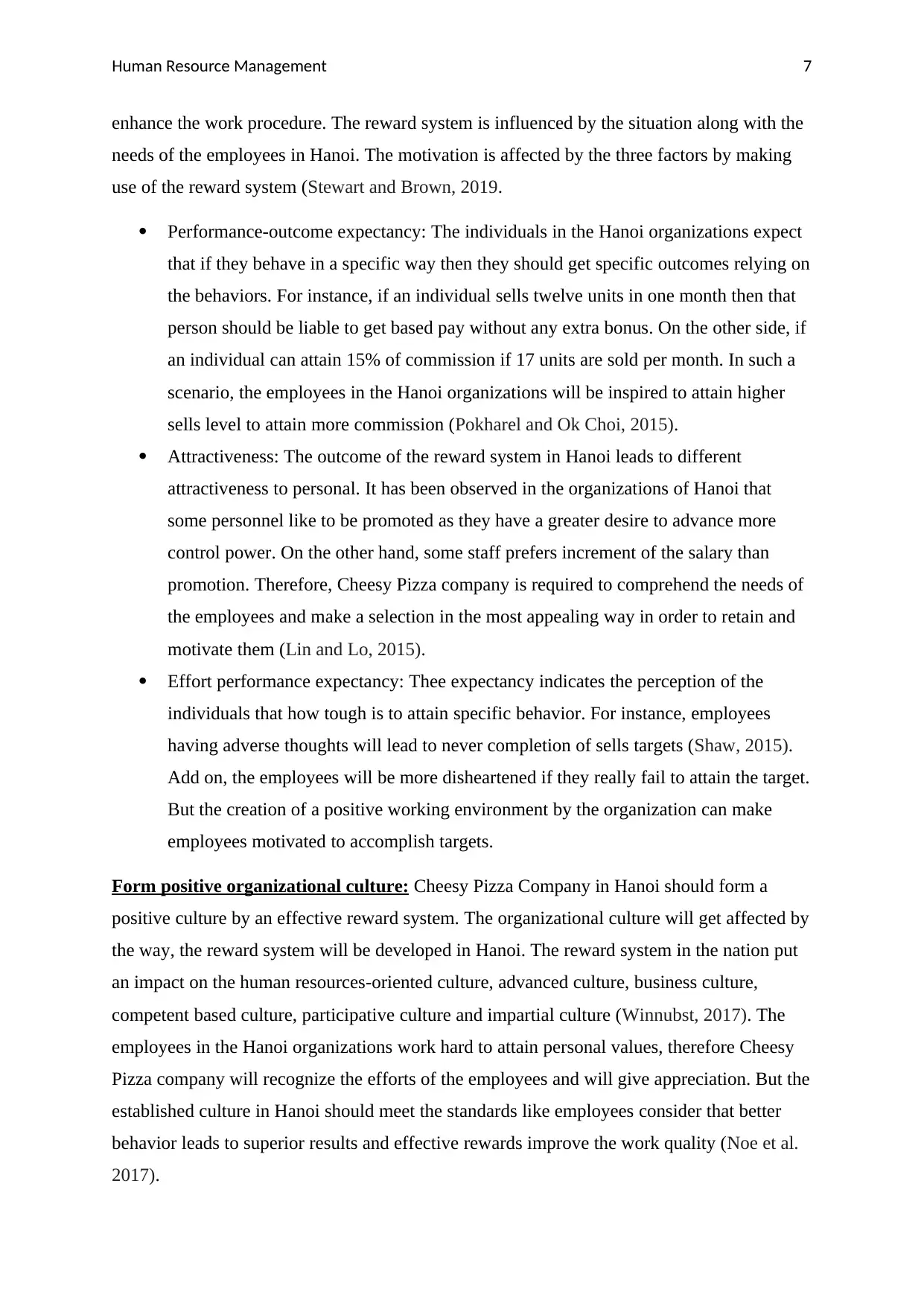
Human Resource Management 7
enhance the work procedure. The reward system is influenced by the situation along with the
needs of the employees in Hanoi. The motivation is affected by the three factors by making
use of the reward system (Stewart and Brown, 2019.
Performance-outcome expectancy: The individuals in the Hanoi organizations expect
that if they behave in a specific way then they should get specific outcomes relying on
the behaviors. For instance, if an individual sells twelve units in one month then that
person should be liable to get based pay without any extra bonus. On the other side, if
an individual can attain 15% of commission if 17 units are sold per month. In such a
scenario, the employees in the Hanoi organizations will be inspired to attain higher
sells level to attain more commission (Pokharel and Ok Choi, 2015).
Attractiveness: The outcome of the reward system in Hanoi leads to different
attractiveness to personal. It has been observed in the organizations of Hanoi that
some personnel like to be promoted as they have a greater desire to advance more
control power. On the other hand, some staff prefers increment of the salary than
promotion. Therefore, Cheesy Pizza company is required to comprehend the needs of
the employees and make a selection in the most appealing way in order to retain and
motivate them (Lin and Lo, 2015).
Effort performance expectancy: Thee expectancy indicates the perception of the
individuals that how tough is to attain specific behavior. For instance, employees
having adverse thoughts will lead to never completion of sells targets (Shaw, 2015).
Add on, the employees will be more disheartened if they really fail to attain the target.
But the creation of a positive working environment by the organization can make
employees motivated to accomplish targets.
Form positive organizational culture: Cheesy Pizza Company in Hanoi should form a
positive culture by an effective reward system. The organizational culture will get affected by
the way, the reward system will be developed in Hanoi. The reward system in the nation put
an impact on the human resources-oriented culture, advanced culture, business culture,
competent based culture, participative culture and impartial culture (Winnubst, 2017). The
employees in the Hanoi organizations work hard to attain personal values, therefore Cheesy
Pizza company will recognize the efforts of the employees and will give appreciation. But the
established culture in Hanoi should meet the standards like employees consider that better
behavior leads to superior results and effective rewards improve the work quality (Noe et al.
2017).
enhance the work procedure. The reward system is influenced by the situation along with the
needs of the employees in Hanoi. The motivation is affected by the three factors by making
use of the reward system (Stewart and Brown, 2019.
Performance-outcome expectancy: The individuals in the Hanoi organizations expect
that if they behave in a specific way then they should get specific outcomes relying on
the behaviors. For instance, if an individual sells twelve units in one month then that
person should be liable to get based pay without any extra bonus. On the other side, if
an individual can attain 15% of commission if 17 units are sold per month. In such a
scenario, the employees in the Hanoi organizations will be inspired to attain higher
sells level to attain more commission (Pokharel and Ok Choi, 2015).
Attractiveness: The outcome of the reward system in Hanoi leads to different
attractiveness to personal. It has been observed in the organizations of Hanoi that
some personnel like to be promoted as they have a greater desire to advance more
control power. On the other hand, some staff prefers increment of the salary than
promotion. Therefore, Cheesy Pizza company is required to comprehend the needs of
the employees and make a selection in the most appealing way in order to retain and
motivate them (Lin and Lo, 2015).
Effort performance expectancy: Thee expectancy indicates the perception of the
individuals that how tough is to attain specific behavior. For instance, employees
having adverse thoughts will lead to never completion of sells targets (Shaw, 2015).
Add on, the employees will be more disheartened if they really fail to attain the target.
But the creation of a positive working environment by the organization can make
employees motivated to accomplish targets.
Form positive organizational culture: Cheesy Pizza Company in Hanoi should form a
positive culture by an effective reward system. The organizational culture will get affected by
the way, the reward system will be developed in Hanoi. The reward system in the nation put
an impact on the human resources-oriented culture, advanced culture, business culture,
competent based culture, participative culture and impartial culture (Winnubst, 2017). The
employees in the Hanoi organizations work hard to attain personal values, therefore Cheesy
Pizza company will recognize the efforts of the employees and will give appreciation. But the
established culture in Hanoi should meet the standards like employees consider that better
behavior leads to superior results and effective rewards improve the work quality (Noe et al.
2017).
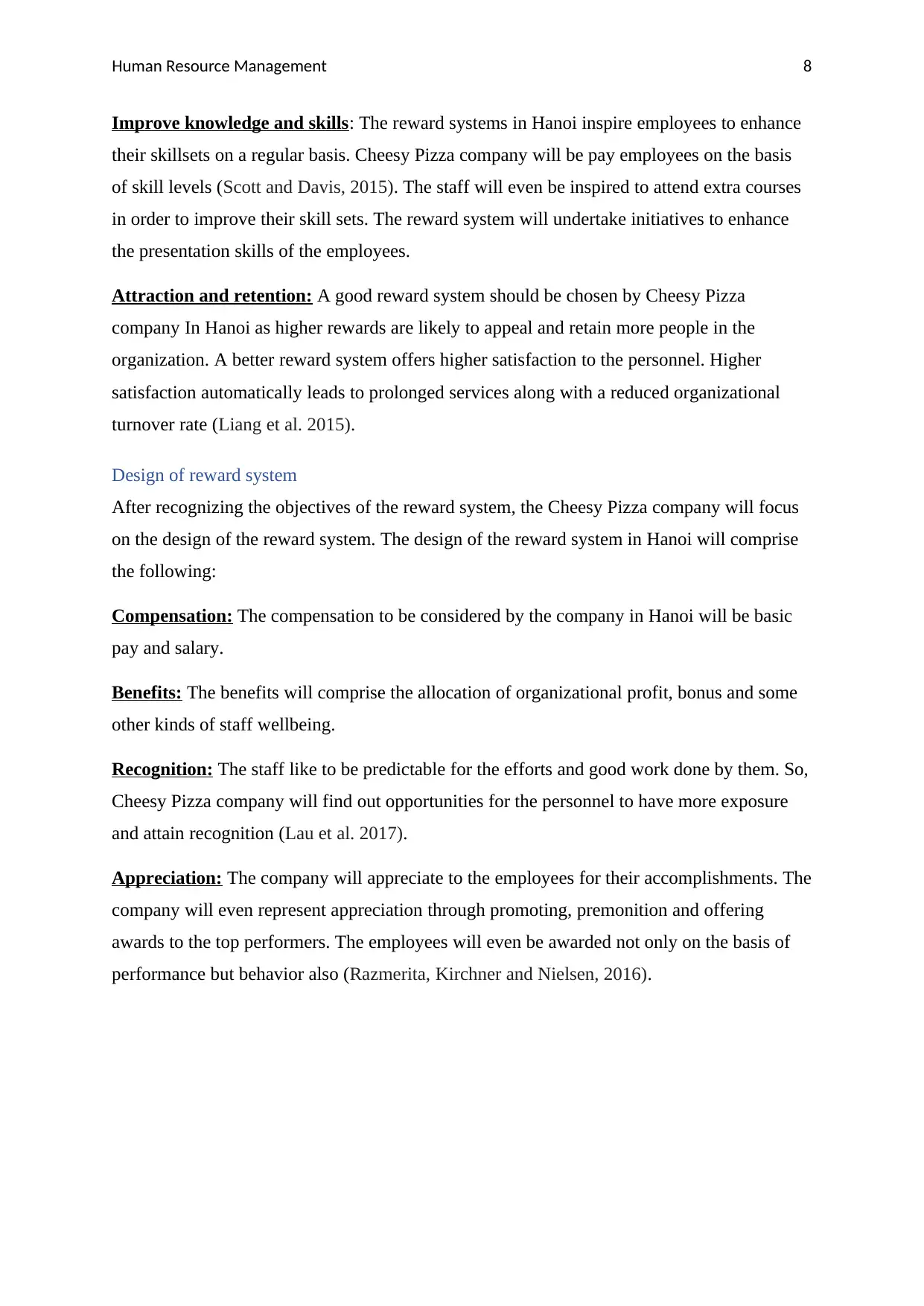
Human Resource Management 8
Improve knowledge and skills: The reward systems in Hanoi inspire employees to enhance
their skillsets on a regular basis. Cheesy Pizza company will be pay employees on the basis
of skill levels (Scott and Davis, 2015). The staff will even be inspired to attend extra courses
in order to improve their skill sets. The reward system will undertake initiatives to enhance
the presentation skills of the employees.
Attraction and retention: A good reward system should be chosen by Cheesy Pizza
company In Hanoi as higher rewards are likely to appeal and retain more people in the
organization. A better reward system offers higher satisfaction to the personnel. Higher
satisfaction automatically leads to prolonged services along with a reduced organizational
turnover rate (Liang et al. 2015).
Design of reward system
After recognizing the objectives of the reward system, the Cheesy Pizza company will focus
on the design of the reward system. The design of the reward system in Hanoi will comprise
the following:
Compensation: The compensation to be considered by the company in Hanoi will be basic
pay and salary.
Benefits: The benefits will comprise the allocation of organizational profit, bonus and some
other kinds of staff wellbeing.
Recognition: The staff like to be predictable for the efforts and good work done by them. So,
Cheesy Pizza company will find out opportunities for the personnel to have more exposure
and attain recognition (Lau et al. 2017).
Appreciation: The company will appreciate to the employees for their accomplishments. The
company will even represent appreciation through promoting, premonition and offering
awards to the top performers. The employees will even be awarded not only on the basis of
performance but behavior also (Razmerita, Kirchner and Nielsen, 2016).
Improve knowledge and skills: The reward systems in Hanoi inspire employees to enhance
their skillsets on a regular basis. Cheesy Pizza company will be pay employees on the basis
of skill levels (Scott and Davis, 2015). The staff will even be inspired to attend extra courses
in order to improve their skill sets. The reward system will undertake initiatives to enhance
the presentation skills of the employees.
Attraction and retention: A good reward system should be chosen by Cheesy Pizza
company In Hanoi as higher rewards are likely to appeal and retain more people in the
organization. A better reward system offers higher satisfaction to the personnel. Higher
satisfaction automatically leads to prolonged services along with a reduced organizational
turnover rate (Liang et al. 2015).
Design of reward system
After recognizing the objectives of the reward system, the Cheesy Pizza company will focus
on the design of the reward system. The design of the reward system in Hanoi will comprise
the following:
Compensation: The compensation to be considered by the company in Hanoi will be basic
pay and salary.
Benefits: The benefits will comprise the allocation of organizational profit, bonus and some
other kinds of staff wellbeing.
Recognition: The staff like to be predictable for the efforts and good work done by them. So,
Cheesy Pizza company will find out opportunities for the personnel to have more exposure
and attain recognition (Lau et al. 2017).
Appreciation: The company will appreciate to the employees for their accomplishments. The
company will even represent appreciation through promoting, premonition and offering
awards to the top performers. The employees will even be awarded not only on the basis of
performance but behavior also (Razmerita, Kirchner and Nielsen, 2016).
⊘ This is a preview!⊘
Do you want full access?
Subscribe today to unlock all pages.

Trusted by 1+ million students worldwide
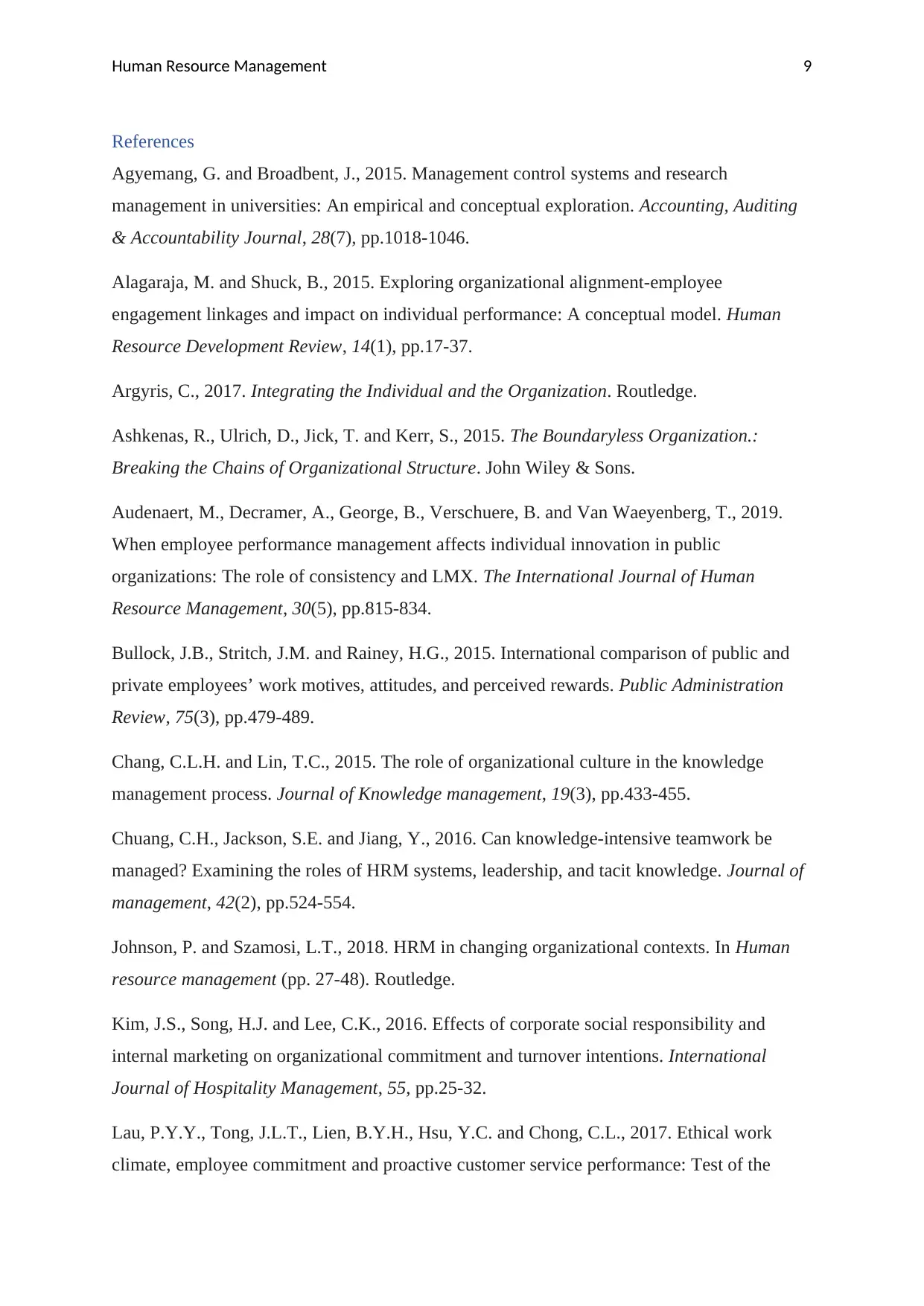
Human Resource Management 9
References
Agyemang, G. and Broadbent, J., 2015. Management control systems and research
management in universities: An empirical and conceptual exploration. Accounting, Auditing
& Accountability Journal, 28(7), pp.1018-1046.
Alagaraja, M. and Shuck, B., 2015. Exploring organizational alignment-employee
engagement linkages and impact on individual performance: A conceptual model. Human
Resource Development Review, 14(1), pp.17-37.
Argyris, C., 2017. Integrating the Individual and the Organization. Routledge.
Ashkenas, R., Ulrich, D., Jick, T. and Kerr, S., 2015. The Boundaryless Organization.:
Breaking the Chains of Organizational Structure. John Wiley & Sons.
Audenaert, M., Decramer, A., George, B., Verschuere, B. and Van Waeyenberg, T., 2019.
When employee performance management affects individual innovation in public
organizations: The role of consistency and LMX. The International Journal of Human
Resource Management, 30(5), pp.815-834.
Bullock, J.B., Stritch, J.M. and Rainey, H.G., 2015. International comparison of public and
private employees’ work motives, attitudes, and perceived rewards. Public Administration
Review, 75(3), pp.479-489.
Chang, C.L.H. and Lin, T.C., 2015. The role of organizational culture in the knowledge
management process. Journal of Knowledge management, 19(3), pp.433-455.
Chuang, C.H., Jackson, S.E. and Jiang, Y., 2016. Can knowledge-intensive teamwork be
managed? Examining the roles of HRM systems, leadership, and tacit knowledge. Journal of
management, 42(2), pp.524-554.
Johnson, P. and Szamosi, L.T., 2018. HRM in changing organizational contexts. In Human
resource management (pp. 27-48). Routledge.
Kim, J.S., Song, H.J. and Lee, C.K., 2016. Effects of corporate social responsibility and
internal marketing on organizational commitment and turnover intentions. International
Journal of Hospitality Management, 55, pp.25-32.
Lau, P.Y.Y., Tong, J.L.T., Lien, B.Y.H., Hsu, Y.C. and Chong, C.L., 2017. Ethical work
climate, employee commitment and proactive customer service performance: Test of the
References
Agyemang, G. and Broadbent, J., 2015. Management control systems and research
management in universities: An empirical and conceptual exploration. Accounting, Auditing
& Accountability Journal, 28(7), pp.1018-1046.
Alagaraja, M. and Shuck, B., 2015. Exploring organizational alignment-employee
engagement linkages and impact on individual performance: A conceptual model. Human
Resource Development Review, 14(1), pp.17-37.
Argyris, C., 2017. Integrating the Individual and the Organization. Routledge.
Ashkenas, R., Ulrich, D., Jick, T. and Kerr, S., 2015. The Boundaryless Organization.:
Breaking the Chains of Organizational Structure. John Wiley & Sons.
Audenaert, M., Decramer, A., George, B., Verschuere, B. and Van Waeyenberg, T., 2019.
When employee performance management affects individual innovation in public
organizations: The role of consistency and LMX. The International Journal of Human
Resource Management, 30(5), pp.815-834.
Bullock, J.B., Stritch, J.M. and Rainey, H.G., 2015. International comparison of public and
private employees’ work motives, attitudes, and perceived rewards. Public Administration
Review, 75(3), pp.479-489.
Chang, C.L.H. and Lin, T.C., 2015. The role of organizational culture in the knowledge
management process. Journal of Knowledge management, 19(3), pp.433-455.
Chuang, C.H., Jackson, S.E. and Jiang, Y., 2016. Can knowledge-intensive teamwork be
managed? Examining the roles of HRM systems, leadership, and tacit knowledge. Journal of
management, 42(2), pp.524-554.
Johnson, P. and Szamosi, L.T., 2018. HRM in changing organizational contexts. In Human
resource management (pp. 27-48). Routledge.
Kim, J.S., Song, H.J. and Lee, C.K., 2016. Effects of corporate social responsibility and
internal marketing on organizational commitment and turnover intentions. International
Journal of Hospitality Management, 55, pp.25-32.
Lau, P.Y.Y., Tong, J.L.T., Lien, B.Y.H., Hsu, Y.C. and Chong, C.L., 2017. Ethical work
climate, employee commitment and proactive customer service performance: Test of the
Paraphrase This Document
Need a fresh take? Get an instant paraphrase of this document with our AI Paraphraser
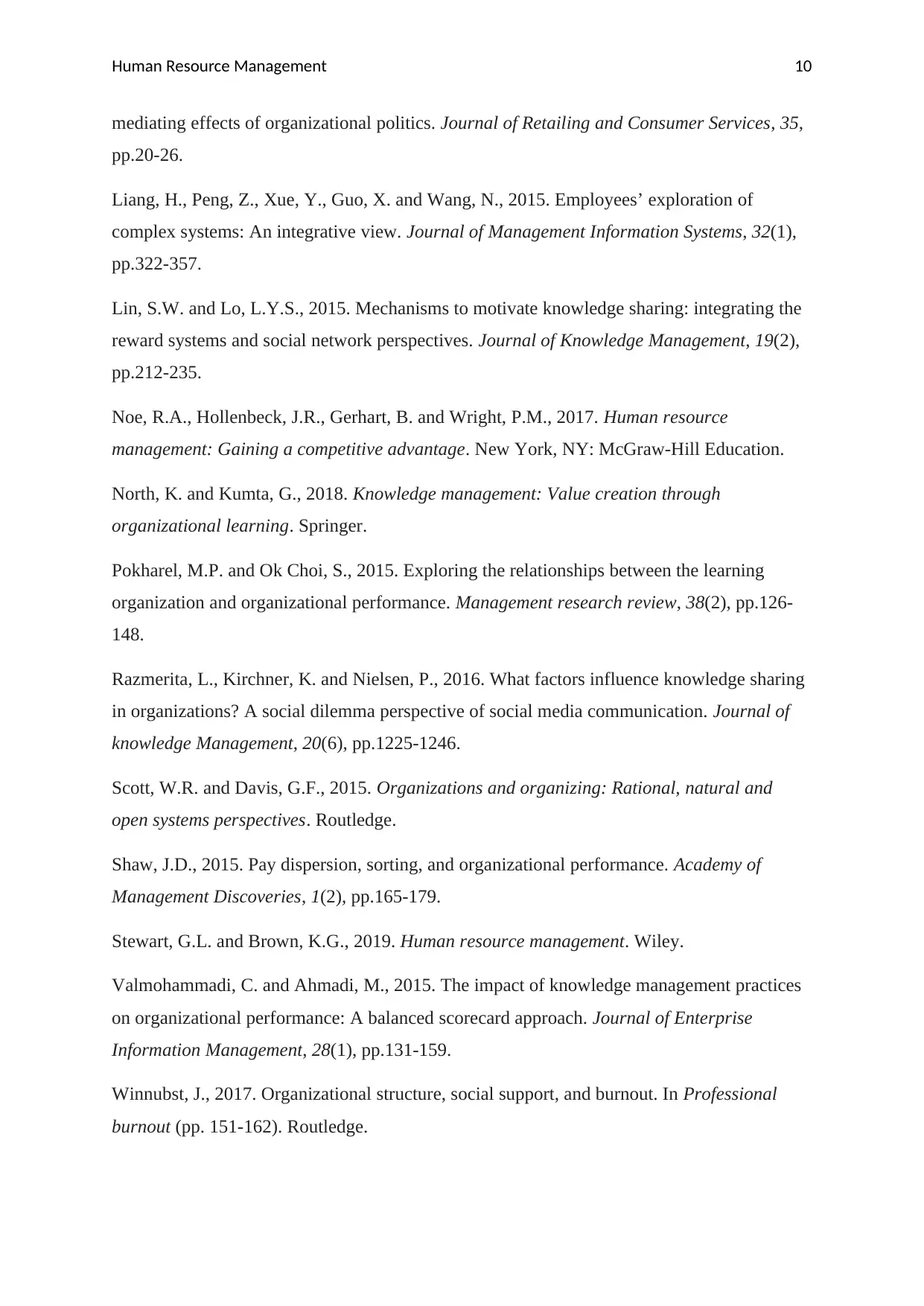
Human Resource Management 10
mediating effects of organizational politics. Journal of Retailing and Consumer Services, 35,
pp.20-26.
Liang, H., Peng, Z., Xue, Y., Guo, X. and Wang, N., 2015. Employees’ exploration of
complex systems: An integrative view. Journal of Management Information Systems, 32(1),
pp.322-357.
Lin, S.W. and Lo, L.Y.S., 2015. Mechanisms to motivate knowledge sharing: integrating the
reward systems and social network perspectives. Journal of Knowledge Management, 19(2),
pp.212-235.
Noe, R.A., Hollenbeck, J.R., Gerhart, B. and Wright, P.M., 2017. Human resource
management: Gaining a competitive advantage. New York, NY: McGraw-Hill Education.
North, K. and Kumta, G., 2018. Knowledge management: Value creation through
organizational learning. Springer.
Pokharel, M.P. and Ok Choi, S., 2015. Exploring the relationships between the learning
organization and organizational performance. Management research review, 38(2), pp.126-
148.
Razmerita, L., Kirchner, K. and Nielsen, P., 2016. What factors influence knowledge sharing
in organizations? A social dilemma perspective of social media communication. Journal of
knowledge Management, 20(6), pp.1225-1246.
Scott, W.R. and Davis, G.F., 2015. Organizations and organizing: Rational, natural and
open systems perspectives. Routledge.
Shaw, J.D., 2015. Pay dispersion, sorting, and organizational performance. Academy of
Management Discoveries, 1(2), pp.165-179.
Stewart, G.L. and Brown, K.G., 2019. Human resource management. Wiley.
Valmohammadi, C. and Ahmadi, M., 2015. The impact of knowledge management practices
on organizational performance: A balanced scorecard approach. Journal of Enterprise
Information Management, 28(1), pp.131-159.
Winnubst, J., 2017. Organizational structure, social support, and burnout. In Professional
burnout (pp. 151-162). Routledge.
mediating effects of organizational politics. Journal of Retailing and Consumer Services, 35,
pp.20-26.
Liang, H., Peng, Z., Xue, Y., Guo, X. and Wang, N., 2015. Employees’ exploration of
complex systems: An integrative view. Journal of Management Information Systems, 32(1),
pp.322-357.
Lin, S.W. and Lo, L.Y.S., 2015. Mechanisms to motivate knowledge sharing: integrating the
reward systems and social network perspectives. Journal of Knowledge Management, 19(2),
pp.212-235.
Noe, R.A., Hollenbeck, J.R., Gerhart, B. and Wright, P.M., 2017. Human resource
management: Gaining a competitive advantage. New York, NY: McGraw-Hill Education.
North, K. and Kumta, G., 2018. Knowledge management: Value creation through
organizational learning. Springer.
Pokharel, M.P. and Ok Choi, S., 2015. Exploring the relationships between the learning
organization and organizational performance. Management research review, 38(2), pp.126-
148.
Razmerita, L., Kirchner, K. and Nielsen, P., 2016. What factors influence knowledge sharing
in organizations? A social dilemma perspective of social media communication. Journal of
knowledge Management, 20(6), pp.1225-1246.
Scott, W.R. and Davis, G.F., 2015. Organizations and organizing: Rational, natural and
open systems perspectives. Routledge.
Shaw, J.D., 2015. Pay dispersion, sorting, and organizational performance. Academy of
Management Discoveries, 1(2), pp.165-179.
Stewart, G.L. and Brown, K.G., 2019. Human resource management. Wiley.
Valmohammadi, C. and Ahmadi, M., 2015. The impact of knowledge management practices
on organizational performance: A balanced scorecard approach. Journal of Enterprise
Information Management, 28(1), pp.131-159.
Winnubst, J., 2017. Organizational structure, social support, and burnout. In Professional
burnout (pp. 151-162). Routledge.
1 out of 11
Related Documents
Your All-in-One AI-Powered Toolkit for Academic Success.
+13062052269
info@desklib.com
Available 24*7 on WhatsApp / Email
![[object Object]](/_next/static/media/star-bottom.7253800d.svg)
Unlock your academic potential
Copyright © 2020–2025 A2Z Services. All Rights Reserved. Developed and managed by ZUCOL.


